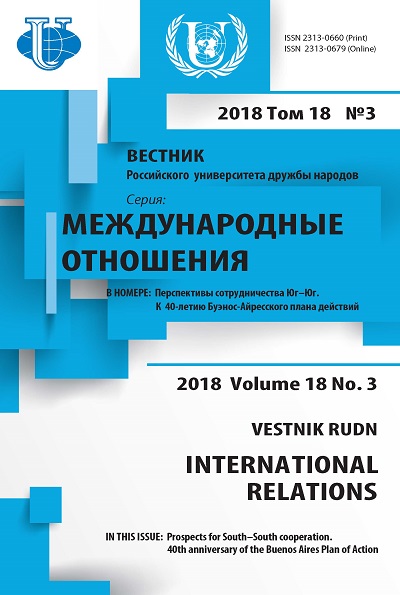THE ROLE OF THE NDB AND AIIB IN CATALYZING PRIVATE INFRASTRUCTURE FINANCING
- Authors: Shelepov A.V.1
-
Affiliations:
- Russian Presidential Academy of National Economy and Public Administration
- Issue: Vol 18, No 3 (2018): Prospects for South—South Cooperation. 40th Anniversary of the Buenos Aires Plan of Action
- Pages: 656-672
- Section: INTERNATIONAL ECONOMIC RELATIONS
- URL: https://journals.rudn.ru/international-relations/article/view/20110
- DOI: https://doi.org/10.22363/2313-0660-2018-18-3-656-672
Cite item
Full Text
Abstract
The article is focused on the activities of two recently established multilateral development banks (MDBs) - the BRICS New Development Bank (NDB) and Asian Infrastructure Investment Bank (AIIB) - in mobilizing private infrastructure investment. Unlike other MDBs, these banks specialize exclusively on sustainable infrastructure projects and are currently creating mechanisms to attract private investment. These factors, as well as Russia’s leading role in both banks, make it necessary to study the mechanisms used by the NDB and AIIB to mobilize private sector funds and make recommendations for their further expansion and development. To achieve this goal, this article presents an analysis of both banks’ documents providing for their engagement with the private sector and mobilizing its resources, and compares qualitative and quantitative characteristics of practical cooperation between private investors and the two MDBs. Based on the analysis, the author makes recommendations on improving and expanding the list of mechanisms used to mobilize private financing. In particular, the AIIB, following the NDB example, should start attracting capital in the member countries financial markets as soon as possible. The NDB needs to ensure the prompt launch of its Project Preparation Fund operations, while the similar AIIB’s fund should focus on raising funds from private investors to finance its activities. It will also be instrumental for the NDB to clearly formulate a strategy for financing loans without sovereign guarantees. In addition, both banks should expand the set of tools used for mobilizing private investment and consider provision of guarantees, expert work and support directly to borrowing countries, as well as exchange of experience and participation in joint projects.
About the authors
Andrei Vladimirovich Shelepov
Russian Presidential Academy of National Economy and Public Administration
Author for correspondence.
Email: shelepov-av@ranepa.ru
Researcher, Center for International Institutions Research (CIIR), Russian Presidential Academy of National Economy and Public Administration, Russian Federation
References
- An Integrated World Bank Group Approach. Leveraging the Private Sector in IDA Countries. (2017). World bank. URL: http://ida.worldbank.org/sites/default/files/pdfs/ida-private-sector2017-rus.pdf (accessed 10.08.2018).
- Asia infrastructure financing. (2016). Deutsche Bank. URL: https://www.dbresearch.com/PROD/ RPS_EN-PROD/Asia_infrastructure_financing/RPS_EN_DOC_VIEW.calias?rwnode= PROD0000000000435629&ProdCollection=PROD0000000000452069 (accessed 10.08.2018).
- Bhattacharyay, B.N. (2010). Estimating Demand for Infrastructure in Energy, Transport, Telecommunications, Water and Sanitation in Asia and the Pacific: 2010—2020. ADBI Working Paper Series, 248. URL: https://openaccess.adb.org/handle/11540/3836 (accessed 10.08.2018).
- Bruck, N. (1998). The Role of Development Banks in the Twenty-First Century. Journal of Emerging Markets, 3, 61—90. URL: http://www.adfiap.org/wp-content/uploads/2009/10/the-role-of-development-banks-in-the-twenty-first-century.pdf (accessed 10.08.2018).
- Ehlers, T. (2014). Understanding the challenges for infrastructure finance. BIS working paper N 454. Bank for International Settlements. URL: http://www.bis.org/publ/work454.pdf (accessed 10.08.2018).
- Faure, R. et al. (2015). Multilateral development banks: a short guide. Overseas Development Institute. URL: https://www.odi.org/sites/odi.org.uk/files/resource-documents/10650.pdf/ (accessed 10.08.2018).
- From billions to trillions: transforming development finance. Post-2015 financing for development: multilateral development finance. (2015). Multilateral development banks. URL: http://siteresources.worldbank.org/DEVCOMMINT/Documentation/23659446/DC20150002(E)FinancingforDevelopment.pdf (accessed 10.08.2018).
- Griffith-Jones, S. (2014). A BRICS Development Bank: A dream come true? UNCTAD Discussion Paper No. 215. URL: https://unctad.org/meetings/en/SessionalDocuments/tdb_efd1_bp_GP2_ en.pdf (accessed 10.08.2018).
- Griffith-Jones, S. (2016). What Can the Asian Infrastructure Investment Bank Learn from Other Development Banks? IDS Policy Briefing no. 113. URL: https://opendocs.ids.ac.uk/opendocs/ bitstream/handle/123456789/11170/PB113_AGID545_AIIB_Online.pdf;sequence=1 (accessed 10.08.2018).
- Humphrey, C. (2014). Challenges and Opportunities for Multilateral Development Banks in Twentyfirst Century Infrastructure Finance. Group of 24 Special Paper Series on Infrastructure Finance and Development. URL: https://www.g24.org/wp-content/uploads/2016/05/MARGGK-WP08.pdf (accessed 10.08.2018).
- Humphrey, C. (2017). Six proposals to strengthen the finances of multilateral development banks. ODI Working Paper 509. 2017. URL: https://www.odi.org/sites/odi.org.uk/files/resourcedocuments/11451.pdf (accessed 10.08.2018).
- Infrastructure to 2030. Vol. 2. Mapping policy for electricity, water and transport. (2007). OECD. URL: https://www.oecd.org/futures/infrastructureto2030/40953164.pdf (accessed 10.08.2018).
- Insight: Blended finance in the national planning process. (2017). Deloitte. URL: https://www2.deloitte.com/content/dam/Deloitte/global/Documents/About-Deloitte/gx-blendedfinance-in-national-planning-process.pdf (accessed 10.08.2018).
- Kamal, R. & Gallagher, K.P. (2016). China goes global with development banks. Bretton Woods Project. URL: https://www.brettonwoodsproject.org/wp-content/uploads/2016/04/At-IssueChina-goes-global-with-development-banks.pdf (accessed 10.08.2018).
- Mobilization of private finance by multilateral development banks. 2016 Joint Report. (2017). Multilateral development banks. URL: http://documents.worldbank.org/curated/en/ 860721492635844277/pdf/114433-REVISED-11p-MDB-Joint-Report-Mobilization-Jul21.pdf (accessed 10.08.2018).
- Montes, M. (2016). Five Points on the Addis Ababa Action Agenda. South Centre Policy Brief no. 24. Shelepov, A. (2017). New and Traditional Multilateral Development Banks: Current and Potential
- Cooperation. International Organisations Research Journal, vol. 12, no 1, pp. 127—147. (in Russian and English). doi: 10.17323/1996-7845-2017-01-127.
- Southeast Asia at the crossroads: Three paths to prosperity. (2014). McKinsey Global Institute. URL: https://www.mckinsey.com/~/media/McKinsey/Featured%20Insights/Asia%20Pacific/ Three%20paths%20to%20sustained%20economic%20growth%20in%20Southeast%20Asia/ Southeast_Asia_at_the_crossroads_Three_paths_to_prosperity_Full%20report.ashx (accessed 10.08.2018).
- The Role of Development Banks in Promoting Growth and Sustainable Development in the South. (2016). UNCTAD. URL: https://unctad.org/en/PublicationsLibrary/gdsecidc2016d1_en.pdf (accessed 10.08.2018).
- Trade and Development Report, 2015: Making the international financial architecture work for development. (2015). UNCTAD. URL: https://unctad.org/en/PublicationsLibrary/tdr2015_en.pdf (accessed 10.08.2018).











